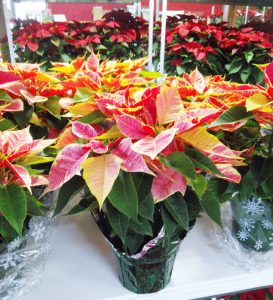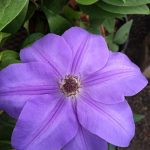
What does a Hydrangea Leaf Joint look like? See Below




with Chip Jones












Wholesale Nursery and Plant Supplies




































 Would you like to work with us and join the Sanders Team?
Would you like to work with us and join the Sanders Team?Mon-Sat: 8am – 5pm
Sundays: Closed
Get Map: Click Here

It’s hot enough to fry baloney on the sidewalk, and you’re worried about how the heat will affect your flowers, trees, shrubs and lawn. Here in the Southern Midwest, those weeks-long stretches between rainfalls can dry up even some drought-tolerant plants. Watering is essential during the summer growing season, and there are some easy ways we can be ‘water-wise’ as we nurture nature:
• Don’t drown your plants or over-water your lawn. Water your lawn only when it needs water. If it crunches when you walk on it, it’s screaming for water! If its color is turning to shades of blue-gray, brown or yellow, it’s dying! If footprints don’t pop back up into healthy blades, it’s thirsty.
• Water grass at least weekly, unless you’ve had a good, soaking rain. Small water amounts lead to shallow root systems. To encourage deeper root systems, give less frequent but larger water amounts to plants and shrubs. Use a moisture gauge to determine the need.
• Different types of grass, plants and flowers require different amounts and frequencies of water. Too much water can prevent oxygen from reaching the roots, building ‘root rot’ and causing the plant to die. Over-watering kills many flowers and plants.
• Most lawns need one inch of water every week. That’s a deep watering to the roots, but only when needed.
• Windy weather, especially during hot temperatures, dries up the ground very quickly, which may necessitate an additional watering or two.
• Water that puddles around the base of the tree or plant, or runs in streams through the grass, is a signal to stop watering until the water has soaked into the ground, then resume watering until you feel you have watered at least one inch.
• It’s not necessary to water the leaves of trees and plants, or outside the root zone of a shrub or perennial. Plants, shrubs and trees should be watered to their drip line.
• Plants and shrubs planted in full sun along the foundation of your home may require more watering than others, as the sun’s rays are reflected off the building and the building may hold in the heat. Monitor the moisture of plants located under the home’s eaves, where raindrops may not reach.
• Do not allow newly planted shrubs and trees to dry out. Although flowers will usually bounce back to life when finally watered, newly planted shrubs and trees are unforgiving and may be destined for the wood pile if not sufficiently watered.
• Newly sodded lawns, lawns recently seeded and lawns with problem areas usually require more frequently watering than established grasses.
• Plants, trees and flowers located on hillsides and slopes require a special watering technique, to prevent the water from running down the slope before it sinks into the root base. Water for a few seconds slowly, then remove or turn off the water until the water you’ve just applied sinks down into the roots. Then give it a little more water and repeat this procedure until you feel you have sufficiently watered and the water has reached down to the roots. You may want to invest in a soaker hose or sprinkler system to make watering hillside plants easier.
Some reasons plants, flowers and shrubs die:
Gadgets that make watering a snap:
Sanders Says … The customer service staff at Sanders Nursery and Distribution Center in Broken Arrow, Oklahoma, will be happy to help with your questions and can direct you to the gadgets and equipment necessary for keeping your lawn and plants beautiful.

Hooray – It’s Spring and Time to Plant!
A few solid tips will help you bring home the best quality, most-likely-to-succeed bedding plants for your garden:
Even color in the leaves. The plant displays an even coloring (a “sameness” of color) on all the leaves and the leaves look healthy. They are not wilted or sticky and their edges are not a different color.
Lots of buds. The plant holds promise of beauty because it is covered with flower buds, making it a better choice than one that’s already in bloom.
Shorter stems and healthy roots. It’s a happy, healthy plant with stocky stems and full of leaves. Taller stems with only a few leaves are beanpoles, and they’re “older” or have resided in their container for much too long. Another clue to the plant’s being overage is a jumble of roots and very little soil.
Just ask! Sanders’ customer service staff is here to help.

 The fastest way to get that deep layer of fertile soil is to make raised beds. Raised beds yield up to four times more than the same amount of space planted in rows. That’s due not only to their loose, fertile soil but also to efficient spacing—by using less space for paths, you have more room to grow plants.
The fastest way to get that deep layer of fertile soil is to make raised beds. Raised beds yield up to four times more than the same amount of space planted in rows. That’s due not only to their loose, fertile soil but also to efficient spacing—by using less space for paths, you have more room to grow plants.
Raised beds save you time, too. One researcher tracked the time it took to plant and maintain a 30-by-30-foot garden planted in beds, and found that he needed to spend just 27 hours in the garden from mid-May to mid-October. Yet he was able to harvest 1,900 pounds of fresh vegetables—that’s a year’s supply of food for three people from about 3 total days of work!
How do raised beds save so much time? Plants grow close enough together to shade out competing weeds so you spend less time weeding. The close spacing also makes watering and harvesting more efficient.
Related: The Ultimate Compost Bin
The shape of your beds can make a difference, too. Raised beds are more space-efficient if the tops are gently rounded to form an arc. A rounded bed that is 5 feet wide across its base, for instance, will give you a 6-foot-wide arc above it—creating a planting surface that’s a foot wider than that of a flat bed. That foot might not seem like much, but multiply it by the length of your bed and you’ll see that it can make a big difference in total planting area.
In a 20-foot-long bed, for example, rounding the top increases your total planting area from 100 to 120 square feet. That’s a 20 percent gain in planting space in a bed that takes up the same amount of ground space. Lettuce, spinach, and other greens are perfect crops for planting on the edges of a rounded bed.

Winter is the perfect time to prune most trees because (A) most trees are dormant and not growing, and (B) in the absence of leaves, it is easy to see where pruning is needed and even easier to do the work.
But don’t prune just to be pruning. Some of the reasons we prune trees include:
With a few exceptions, prune most deciduous (hardwood) trees while they are dormant in Winter. Exceptions include trees like Maple, Birch and Dogwood, which have a sap and resin flow during Spring (pruning in Winter would negatively affect the sap/resin flow). These trees should be pruned in late Fall.
Prune flowering trees and shrubs that flower in the Spring immediately after they are done flowering.
Prune trees and shrubs that flower in Summer any time you wish – but NOT when it’s really hot, as that is when insects are highly active and can migrate to other plants.
Prune evergreens in early to mid-Summer but not if it is very hot. Never prune evergreens in late Summer or Fall. When you prune, you can cut back from 50 to 90 percent of new growth every year to get more compact growth.
Check with the Sanders customer service staff for expert advice.

The weather outside is frightful but the Poinsettia’s are so delightful. Get your home holiday ready with Poinsettia’s from Sanders Nursery. Grown in our state of the art parent facility Park Hill Plants.


Great as Teacher or Hostess Gifts
Multiple Sizes and Colors Available
Perfect for Fundraiser’s & Churches
______________________________________________
Beautiful Poinsettia Tree’s

Come by today for a great selection.


